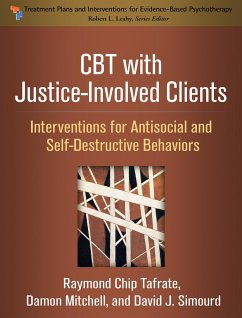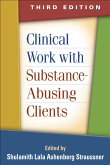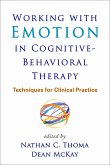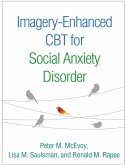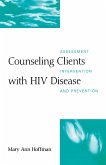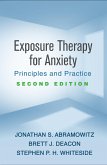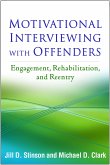Raymond Chip Tafrate, Damon Mitchell, David J Simourd
CBT with Justice-Involved Clients
Interventions for Antisocial and Self-Destructive Behaviors
Raymond Chip Tafrate, Damon Mitchell, David J Simourd
CBT with Justice-Involved Clients
Interventions for Antisocial and Self-Destructive Behaviors
- Gebundenes Buch
- Merkliste
- Auf die Merkliste
- Bewerten Bewerten
- Teilen
- Produkt teilen
- Produkterinnerung
- Produkterinnerung
Grounded in science and clinical experience, this treatment planner provides essential tools for conducting cognitive-behavioral therapy (CBT) with justice-involved clients in a wide range of settings.
Andere Kunden interessierten sich auch für
![Clinical Work with Substance-Abusing Clients Clinical Work with Substance-Abusing Clients]() Clinical Work with Substance-Abusing Clients103,99 €
Clinical Work with Substance-Abusing Clients103,99 €![Working with Emotion in Cognitive-Behavioral Therapy Working with Emotion in Cognitive-Behavioral Therapy]() Working with Emotion in Cognitive-Behavioral Therapy62,99 €
Working with Emotion in Cognitive-Behavioral Therapy62,99 €![Imagery-Enhanced CBT for Social Anxiety Disorder Imagery-Enhanced CBT for Social Anxiety Disorder]() Peter M McEvoyImagery-Enhanced CBT for Social Anxiety Disorder65,99 €
Peter M McEvoyImagery-Enhanced CBT for Social Anxiety Disorder65,99 €![Counseling Clients with HIV Disease Counseling Clients with HIV Disease]() Mary Ann HoffmanCounseling Clients with HIV Disease46,99 €
Mary Ann HoffmanCounseling Clients with HIV Disease46,99 €![Cognitive-Behavioral Therapies with Lesbian, Gay, and Bisexual Clients Cognitive-Behavioral Therapies with Lesbian, Gay, and Bisexual Clients]() Christopher R MartellCognitive-Behavioral Therapies with Lesbian, Gay, and Bisexual Clients45,99 €
Christopher R MartellCognitive-Behavioral Therapies with Lesbian, Gay, and Bisexual Clients45,99 €![Exposure Therapy for Anxiety Exposure Therapy for Anxiety]() Jonathan S AbramowitzExposure Therapy for Anxiety83,99 €
Jonathan S AbramowitzExposure Therapy for Anxiety83,99 €![Motivational Interviewing with Offenders Motivational Interviewing with Offenders]() Jill D StinsonMotivational Interviewing with Offenders60,99 €
Jill D StinsonMotivational Interviewing with Offenders60,99 €-
-
-
Grounded in science and clinical experience, this treatment planner provides essential tools for conducting cognitive-behavioral therapy (CBT) with justice-involved clients in a wide range of settings.
Produktdetails
- Produktdetails
- Verlag: Guilford Publications
- Seitenzahl: 307
- Erscheinungstermin: 25. Mai 2018
- Englisch
- Abmessung: 279mm x 206mm x 25mm
- Gewicht: 953g
- ISBN-13: 9781462534920
- ISBN-10: 1462534929
- Artikelnr.: 48895714
- Herstellerkennzeichnung
- Libri GmbH
- Europaallee 1
- 36244 Bad Hersfeld
- gpsr@libri.de
- Verlag: Guilford Publications
- Seitenzahl: 307
- Erscheinungstermin: 25. Mai 2018
- Englisch
- Abmessung: 279mm x 206mm x 25mm
- Gewicht: 953g
- ISBN-13: 9781462534920
- ISBN-10: 1462534929
- Artikelnr.: 48895714
- Herstellerkennzeichnung
- Libri GmbH
- Europaallee 1
- 36244 Bad Hersfeld
- gpsr@libri.de
Raymond Chip Tafrate, PhD, a clinical psychologist, is Professor of Criminology and Criminal Justice at Central Connecticut State University. He co-chairs the Forensic Issues and Externalizing Behaviors special interest group for the Association for Behavioral and Cognitive Therapies, is a Fellow and Supervisor at the Albert Ellis Institute in New York City, and is a member of the Motivational Interviewing Network of Trainers. Dr. Tafrate frequently consults with criminal justice agencies regarding difficult-to-change problems such as anger dysregulation and criminal behavior. He has presented his research throughout North America, Europe, Asia, and Australia, and has published numerous journal articles, book chapters, and books. Damon Mitchell, PhD, a clinical psychologist, is Professor of Criminology and Criminal Justice at Central Connecticut State University. As a criminal justice consultant, Dr. Mitchell has developed and delivered training workshops related to forensic assessment and treatment and has conducted evaluations of criminal justice programs. He has published numerous journal articles and book chapters as well as a coedited book. David J. Simourd, PhD, CPsych, until his death in 2022, was in private practice in Kingston, Ontario, Canada, and had a 30-year career as a consultant/trainer, clinician, and researcher. Dr. Simourd published articles, delivered training workshops, and served as a consultant on offender assessment and treatment to a variety of correctional organizations throughout North America, Asia, and the Caribbean. He was on the editorial board of Criminal Justice and Behavior and was a member of the Ontario Review Board, the civil commitment board for mentally disordered offenders in Ontario. In 2019, he was elected as a Fellow of the Canadian Psychological Association.
I. Forensic Basics
1. The Forensic Treatment Landscape
2. An Integrated Forensic Cognitive-Behavioral Therapy Approach
II. Engagement
3. Successfully Engaging Justice-Involved Clients
4. Clarifying Values and Life Priorities
III. Assessment, Case Formulation, and Focus
5. Assessing Criminal Risk Domains
6. Case Formulation
7. Establishing Collaborative Goals and Focusing Conversations
IV. Detailed Treatment Plans for Criminogenic Thinking and Antisocial
Orientation
8. Connecting Criminogenic Thinking to Decision Making in Criminal Risk
Domains
9. Monitoring and Restructuring Criminogenic Thinking
V. Detailed Treatment Plans for Harmful Lifestyle Patterns
10. Developing New Routines: Leisure Activities and Employment/Education
11. Restructuring Relationships: Friends and Family
12. Managing Destructive Habits: Substance Use and Anger Reactions
VI. Practice Management
13. Documentation and Report Writing
Postscript
Appendix A. Standardized Test Recommendations
Appendix B. Resources for Practitioners
1. The Forensic Treatment Landscape
2. An Integrated Forensic Cognitive-Behavioral Therapy Approach
II. Engagement
3. Successfully Engaging Justice-Involved Clients
4. Clarifying Values and Life Priorities
III. Assessment, Case Formulation, and Focus
5. Assessing Criminal Risk Domains
6. Case Formulation
7. Establishing Collaborative Goals and Focusing Conversations
IV. Detailed Treatment Plans for Criminogenic Thinking and Antisocial
Orientation
8. Connecting Criminogenic Thinking to Decision Making in Criminal Risk
Domains
9. Monitoring and Restructuring Criminogenic Thinking
V. Detailed Treatment Plans for Harmful Lifestyle Patterns
10. Developing New Routines: Leisure Activities and Employment/Education
11. Restructuring Relationships: Friends and Family
12. Managing Destructive Habits: Substance Use and Anger Reactions
VI. Practice Management
13. Documentation and Report Writing
Postscript
Appendix A. Standardized Test Recommendations
Appendix B. Resources for Practitioners
I. Forensic Basics
1. The Forensic Treatment Landscape
2. An Integrated Forensic Cognitive-Behavioral Therapy Approach
II. Engagement
3. Successfully Engaging Justice-Involved Clients
4. Clarifying Values and Life Priorities
III. Assessment, Case Formulation, and Focus
5. Assessing Criminal Risk Domains
6. Case Formulation
7. Establishing Collaborative Goals and Focusing Conversations
IV. Detailed Treatment Plans for Criminogenic Thinking and Antisocial
Orientation
8. Connecting Criminogenic Thinking to Decision Making in Criminal Risk
Domains
9. Monitoring and Restructuring Criminogenic Thinking
V. Detailed Treatment Plans for Harmful Lifestyle Patterns
10. Developing New Routines: Leisure Activities and Employment/Education
11. Restructuring Relationships: Friends and Family
12. Managing Destructive Habits: Substance Use and Anger Reactions
VI. Practice Management
13. Documentation and Report Writing
Postscript
Appendix A. Standardized Test Recommendations
Appendix B. Resources for Practitioners
1. The Forensic Treatment Landscape
2. An Integrated Forensic Cognitive-Behavioral Therapy Approach
II. Engagement
3. Successfully Engaging Justice-Involved Clients
4. Clarifying Values and Life Priorities
III. Assessment, Case Formulation, and Focus
5. Assessing Criminal Risk Domains
6. Case Formulation
7. Establishing Collaborative Goals and Focusing Conversations
IV. Detailed Treatment Plans for Criminogenic Thinking and Antisocial
Orientation
8. Connecting Criminogenic Thinking to Decision Making in Criminal Risk
Domains
9. Monitoring and Restructuring Criminogenic Thinking
V. Detailed Treatment Plans for Harmful Lifestyle Patterns
10. Developing New Routines: Leisure Activities and Employment/Education
11. Restructuring Relationships: Friends and Family
12. Managing Destructive Habits: Substance Use and Anger Reactions
VI. Practice Management
13. Documentation and Report Writing
Postscript
Appendix A. Standardized Test Recommendations
Appendix B. Resources for Practitioners

